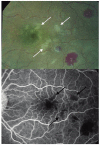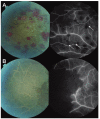Perfusion abnormalities in children with cerebral malaria and malarial retinopathy
- PMID: 18999956
- PMCID: PMC2757304
- DOI: 10.1086/595735
Perfusion abnormalities in children with cerebral malaria and malarial retinopathy
Abstract
Background: In patients with cerebral malaria (CM), retinal angiography allows the study of infected central nervous system microvasculature in vivo. We aimed to examine retinal perfusion in children with CM by use of fluorescein angiography to investigate the pathophysiology of CM.
Methods: We performed fluorescein angiography on children with CM admitted to Queen Elizabeth Central Hospital, Malawi. We related angiograms to funduscopic findings.
Results: Fluorescein angiography was performed for 34 patients with CM, and impaired perfusion was identified in 28 (82%). Areas of capillary nonperfusion (CNP) were seen in 26 patients (76%). Multiple, scattered areas of CNP were typical and topographically matched to retinal whitening. Larger retinal vessels were occluded in 9 patients (26%) who had associated ischemia. These vessels appeared white on ophthalmoscopy. Intravascular abnormalities were seen in 9 patients (26%), including filling defects and mottling of the blood column. Limited fluorescein leakage occurred in 15 patients (44%) and was not related to angiographic intravascular abnormalities or visible vessel discoloration.
Conclusions: Impaired perfusion occurs in the retinal microvasculature of most children with CM. This is evidence for hypoxia and ischemia as important components in the pathogenesis of CM. Vessel occlusion and filling defects are likely to be due to sequestration of infected erythrocytes. Interventions which improve perfusion or limit hypoxic injury may be beneficial in CM.
Figures





References
-
- Bryce J, Boschi-Pinto C, Shibuya K, Black RE. WHO estimates of the causes of death in children. Lancet. 2005;365:1147–52. - PubMed
-
- Marsh K, Forster D, Waruiru C, et al. Indicators of life-threatening malaria in African children. N Engl J Med. 1995;332:1399–404. - PubMed
-
- Lewallen S, White VA, Whitten RO, et al. Clinical-histopathological correlation of the abnormal retinal vessels in cerebral malaria. Arch Ophthalmol. 2000;118:924–8. - PubMed
Publication types
MeSH terms
Grants and funding
LinkOut - more resources
Full Text Sources
Other Literature Sources
Medical

